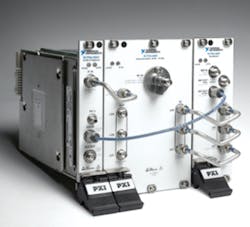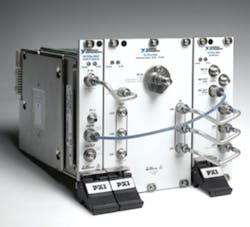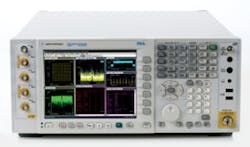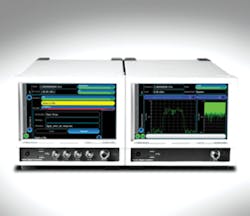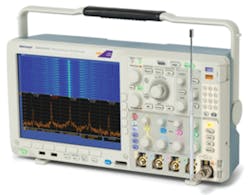Enabling Flexible RF/Microwave Measurements
To help contend with myriad standard and custom signal formats, vendors are offering signal analyzers in various modular and standalone configurations. Signal analyzers complement swept-tuned, superheterodyne spectrum analyzers to add capabilities such as characterizing burst, transient, or modulated wideband signals used in communications. In fact, digital technology and digital signal processing are blurring the distinction between spectrum and signal analyzers.1
Courtesy of National Instruments
And you can obtain spectrum- and signal-analysis capabilities within one instrument. The R&S FSQ Signal Analyzer from Rohde & Schwarz, for example, combines the spectrum analyzer features and functions of the R&S FSU Spectrum Analyzer with wideband signal-analysis capabilities, including 28-MHz or optional 120-MHz signal-analysis bandwidth, +25 dBm typical TOI, a 1-dB compression point of +13 dBm, 84-dBc ACLR/3GPP with noise correction, and -173-dBm (1-Hz) displayed average noise level (DANL) with noise correction and an R&S FSU-B24 Preamplifier. The FSQ features a 16-Msample I/Q memory, expandable to 705 Msamples, and analyzes analog and digital baseband signals. Firmware applications extend its signal analysis capabilities. The instrument operates from 20 Hz to 3.6, 8, 26.5, or 40 GHz and serves in applications such as measuring multistandard-radio base stations.2
Customers can select RF and microwave instruments dedicated to the specific communications standards with which they are working, such as LTE.3 But, as Wilkie Yu, signal analyzer product manager at Agilent Technologies, put it, “Customers today are looking for a measurement platform that can test multiple technologies at one time vs. having lower cost, point solutions. Customers, often in manufacturing, also value the ability to quickly reconfigure and redeploy test assets and update them as needed. Flexible signal analyzer platforms support this desire and therefore hold their value better.”
Agilent offers a range of hardware and software products to support signal analysis. Yu said the combination of X-Series Signal Analyzers (including the PXA, MXA, EXA, and CXA models) with either embedded X-Series measurement applications or 89600 Vector Signal Analysis (VSA) software provides a flexible measurement platform for making swept or FFT-based measurements of CW, pulsed, or digitally modulated signals.
Yu noted that in the commercial space, customers are working with devices that might incorporate WCDMA, LTE, GPS, WLAN, Bluetooth, and other technologies all in one device. And faced with capital constraints imposed by the global economic situation, they want to purchase a product that will serve their needs over the next three, five, or even 10 years. Aerospace/defense customers also are looking for flexibility, in part because they need to detect threats based on commercial technology (cell phones used to detonate IEDs, for example), and because they, too, face constraints on capital spending.
Signal analyzers’ applicability extends to the design stage, said Yu, noting that designers use design, simulation, and math tools as part of the development process and sometimes deal with signals in digitized form. Agilent, he said, uses consistent measurement algorithms (and, to some degree, consistent user interfaces) across its many platforms to improve design productivity and reduce confusion. “We can even use the algorithms (in the form of the same VSA software that runs in the signal analyzers) as analyzers running inside the simulation software, with the same controls and displays,” he said.
To protect customers’ investment, Yu said, Agilent supports independent upgrade of instrument hardware (including I/O, processor, and mass storage), software, and measurement applications. “The useful life of a traditional legacy analyzer often was limited by the processor’s useable life span,” he said. “By architecting all of the X-Series with a removable and upgradeable CPU tray, PC processing power, memory, and I/O connectivity (LAN, USB) enhancements for existing and new analyzers can be made.”
PXI Analyzers
Tim Carey, PXI product manager at Aeroflex, offered a similar viewpoint to Yu’s on the benefits of flexibility: “A flexible signal analyzer, such as the Aeroflex PXI 3030 RF Digitizer, can safeguard capital investment and maximize re-use of hardware for future test requirements.”
Software in the form of different test personalities that can be purchased when required, he said, defines the signal analyzer, making the hardware standard-agnostic. Aeroflex offers sample code in LabVIEW, LabWindows/CVI, Visual Basic, Visual C++, and .NET as well as application notes addressing topics such as ensuring accuracy in RF measurements.4
For the PXI 3000 Series, Aeroflex provides a range of optional demodulation personalities for generic modulation and all major cellular and wireless data protocols, including GSM/EDGE, UMTS/HSPA+, LTE (FDD and TDD), cdma2000, TD-SCDMA (3GPP LCR), WiMAX OFDMA, WLAN 802.11, Bluetooth, and generic modulation (including ZigBee and FM stereo).
Carey said the Aeroflex 3036 RF Digitizer is a recent addition to the PXI 3000 Series of RF modular instruments. The 3036 RF Digitizer is a 3-slot wide module that offers VSA from 250 kHz to 13 GHz. It enables 90-MHz instantaneous measurement bandwidth and high-speed frequency switching in less than 325 µs, which is critical for volume production tests, and it can serve in low-cost ATE signal analysis applications where system size, signal bandwidth, and test speed are critical requirements.
Courtesy of Agilent Technologies
Aeroflex recently released PXI Studio 2 Windows-based software, which Carey called a major update to replace current PXI Studio software. Compared with PXI Studio, PXI Studio 2 improves the user experience when manually operating any configuration of PXI 3000 Series modules, for example, benchtop applications or system integration debugging, Carey said, adding, “This highly flexible application can provide vector signal generation and analysis of complex modulated signals in a single integrated graphical user interface.”
Carey said Aeroflex also recently added 802.11ac support to the PXI 3000 Series of RF modular instruments, which offer wideband signal analysis and generation for frequencies up to 6 GHz, covering the bandwidth and frequency requirements of 802.11ac. Modulation schemes for 802.11ac are fully supported from BPSK to 256 QAM. The 802.11ac solution performs transmitter and receiver measurements and is optimized for manufacturing tests, Carey said.
Raajit Lall, product manager for RF and wireless test at National Instruments, said his company recently announced the NI PXIe-5665 VSA with a frequency range of up to 14 GHz, phase noise of -129 dBc/Hz, and an average noise floor of -165 dBm/Hz. The PXIe-5665 VSA consists of the NI PXIe-5605 Downconverter, the NI PXIe-5653 Local-Oscillator Synthesizer, and the NI PXIe-5622 150-MS/s IF Digitizer.
Lall said the NI PXIe-5665 is standard-agnostic and can be used with RF toolkits supporting standards such as LTE, WCDMA, WLAN, and GPS. NI recently announced support for TD-LTE and Bluetooth as well, Lall said, adding that NI toolkits ship with soft front panels and APIs. He noted that the instrument can serve in high throughput manufacturing test applications as well as in validation and verification environments given its high dynamic range and accuracy.
Since the NI PXIe-5665 is based on a three-stage downconversion process, Lall said, it addresses spectrum-monitoring applications where image rejection is important. NI analyzers also serve aerospace and defense, radar test, semiconductor test, mobile device test, and research applications, he said.
Lall agreed with Yu and Carey that customers can benefit from flexibility when choosing instruments. “Flexible signal analyzers such as the NI PXIe-5665 and the NI PXIe-5663 allow engineers to minimize the cost of their investments since they can use the same hardware for multiple standards.” Because modulation and demodulation take place in software, he said, customers can either purchase software personalities such as those supporting LTE, WLAN, or WCDMA from NI, or they can modify or create their own modulation schemes for custom applications.
Benchtop Configurations
Of course, benchtop and rack-mountable signal analyzers also offer flexibility. Yu at Agilent cited options and applications that add flexibility to Agilent’s X-Series Analyzers, including the N9083A and W9083A Multi-Standard Radio (MSR) measurement application. In addition, the N9080A LTE FDD and N9082A LTE TDD measurement application updates support the 3GPP Release 9 (2010-06) standard.
Also, Agilent recently introduced a 160-MHz analysis-bandwidth option for the PXA Signal Analyzer as well as an 802.11ac signal-analysis tool for the company’s 89600 VSA software. And, for the 89600 VSA software, the company introduced support for multimeasurement signal analysis in wireless test applications as well as support for LTE-Advanced FDD modulation analysis.
to 13 GHz
Courtesy of Aeroflex
Referring to Aeroflex’s S-Series Signal Generator and Analyzer family, Hiren Joshi, S-Series product manager, said, “Many research laboratories, educational institutions, designers, and manufacturers of components and chipsets work on multiple standards. Service centers and system integrators repair and integrate multitechnology devices. For these customers, it makes technological and commercial sense to invest in a flexible signal analyzer that supports multiple technologies.”
The S-Series VSAs, he said, serve several key applications: evaluation and characterization of new-generation wireless devices, satellite communications test, radar test, telemetry, pre-production and production test of baseband and RF components, RFID test, WLAN and Bluetooth card test, and general-purpose research. As for flexibility and upgradeability, Joshi said the instruments incorporate a touch-screen GUI. “The development in the touch-screen technology, combined with the robustness of the operating system, allows us to add software features and new applications at a much faster rate and respond to the market needs quickly,” he said.
Mixing Domains
For its part, Tektronix offers the RSA5000/6000 Series Real-Time Signal Analyzers and last December introduced DPX enhancements for the instruments based on Tektronix’s DPX Display Technology, which optimizes the amount of information a user can observe at a glance. According to Darren McCarthy, technical marketing manager for RF test, the new functionality includes real-time spectrogram and split real-time spectrum and spectrogram viewing. The DPX enhancement is available as a free firmware upgrade for customers that have instruments equipped with Option 200, a customer-installable hardware upgrade to the base product.
Tektronix also is targeting signal analysis with its new MDO4000 Series Mixed-Domain Oscilloscope. This instrument combines a four-channel mixed-signal oscilloscope (with four analog and 16 logic channels) with a fully functional spectrum analyzer. The spectrum analyzer, McCarthy said, is an FFT-based VSA that enables you to view time-correlated spectrums and RF signal amplitude, phase, and frequency vs. time along with the time-domain signals.
McCarthy said the MDO4000 targets the embedded wireless designer who is implementing off-the-shelf technology and can benefit from a simple tool for validating and debugging wireless implementations. In contrast, the advanced user who is developing the wireless technology can employ the advanced functionality of the RSA Real-Time Signal Analyzers to fully characterize the RF behavior of their designs.
McCarthy elaborated on the MDO4000, saying it provides a new set of analysis capabilities that are useful for examining PHY layer performance in accordance with wireless standards and the front-end module performance of wireless devices. “The critical timing analysis of digital commands to an RF event is important to know for optimizing device power efficiency and understanding the critical timing of network communications,” he said. “These measurements now can be analyzed in a single time-correlated acquisition on a single instrument.”
Courtesy of Tektronix
He cited as specific examples the validating of commands and RF events on a MIPI RFFE front-end module in a cell phone or the analysis of the turn-on timing of an RF4CE ZigBee module. For each example, the MDO4000 can show logic-level commands and RF events in a single time-correlated display.
Broadband Signal Analyzers
In addition to the PXI and S-Series Signal Analyzers, Aeroflex offers a line of broadband signal analyzers (BSA), the CS9000 Series. According to Sue Guzman, general manager for Aeroflex Cupertino, in February the company introduced a family of lower cost signal analyzer systems based on the CS9000 line. This family is based on the most popular configuration options in the original line, she said, and resulted in the Scout, Hunter, and Explorer Broadband Signal Analyzers with dual-channel and signal-generator-channel options.
“While Aeroflex’s signal analyzers are applicable to virtually any signal,” Guzman said of the BSA products, “historically, we have served markets with unique or emerging signals that require detailed analysis of complex signals and environments. These markets have included both range and lab test support for radar, EW, ECM/ECCM, radio/communications, satellite payload test, and spectrum monitoring.”
The BSA’s role, she said, “is to help solve difficult design validation and verification problems that typically cannot be solved with other signal analyzers. The combination of wider instantaneous bandwidths and significantly longer record times allows designers to explore exactly what is happening with their signals as well as the environment’s effects on those signals.”
Said Guzman, “From the very beginning, BSAs were built with a modular architecture; this design protected and leveraged our customer’s investment.” The BSA is easily upgradeable to add extended frequency range, longer recording memory, and additional independently tunable input channels. “Our BSA software is architected to easily accept new analysis modules as well as new visualization functions to meet emerging and unique signals,” she said. “This constantly evolving software suite of modules allows the same BSA instrument to be applied to evolving challenges. Through this approach, customers are given the ability to invest in an expandable platform and add capability as it is required.”
References
- “Spectrum Analysis Basics,” Agilent Technologies, Application Note 150, 2006.
- “Measuring Multistandard Radio Base Stations According to TS 37.141,” Application Note, Rohde & Schwarz, December 2011.
- Nelson, R., “Evaluating Cellular Evolution,” EE-Evaluation Engineering, March 2012, p. 14.
- “Assuring Accuracy in Aeroflex PXI RF Test Systems and Modules,” Application Note, Aeroflex, 2007.
For Further Reading
- “Best Practices to Get the Most Out of Your RF Instruments,” Tutorial, National Instruments, 2011 http://zone.ni.com/devzone/cda/tut/p/id/11831
- “Configuring Phase-Coherent RF Measurement Systems: From MIMO to Beamforming,” Tutorial, National Instruments, 2011 http://zone.ni.com/devzone/cda/tut/p/id/9127
- “Fundamentals of the MDO4000 Series Mixed Domain Oscilloscope,” Application Note, Tektronix, 2011 http://www.tek.com/fact-sheet/fundamentals-mdo4000-series-mixed-domain-oscilloscope
- “Hunting Noise Sources in Wireless Embedded Systems,” Application Note, Tektronix, 2011 http://www.tek.com/fact-sheet/hunting-noise-sources-wireless-embedded-systems
- “Integrated ZigBee Radio Implementation and Testing,” Application Note, Tektronix, 2011 http://www.tek.com/fact-sheet/integrated-zigbee-radio-implementation-and-testing
- “Making Wideband Measurements,” Application Note, Agilent Technologies, 2012 http://cp.literature.agilent.com/litweb/pdf/5990-9108EN.pdf
- “Spectrum and Signal Analyzer Measurements and Noise,” Application Note, Agilent Technologies, 2011 http://cp.literature.agilent.com/litweb/pdf/5966-4008E.pdf
- “System Level Design and Verification of Wireless Embedded Systems,” Application Note, Tektronix, 2011 http://www.tek.com/fact-sheet/system-level-design-and-verification-wireless-embedded-systems
- “Using Agilent X-Series Signal Analyzers for Measuring and Troubleshooting Digitally Modulated Signals,” Application Note, Agilent Technologies, 2009
- http://cp.literature.agilent.com/litweb/pdf/5989-4944EN.pdf
- “Vector Signal Analysis Basics,” Application Note, Agilent Technologies, 2011 http://cp.literature.agilent.com/litweb/pdf/5990-7451EN.pdf
